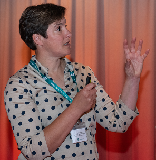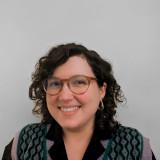Blog
Unless otherwise stated, content is shared under CC-BY-NC Licence
From Physical Archives to Digital Preservation: Reflecting on a Forty-Year Transformation
Holly Duncan is the account executive for Preferred Media and DPC Supporter
More than forty years ago, Preferred Media began as a physical archive, safeguarding film, tape, and disk media for clients across Australia. At the time, the role of an archive was straightforward: provide shelves, cataloguing, and climate control so materials could be stored and retrieved when needed.
Over the decades, preservation has changed. Today, it is not just about storage, but about ensuring media survives rapid technological shifts, remains accessible, and does so in a way that is sustainable.
Tune in to iPRES Radio – Your Daily Dose of Digital Preservation from iPRES 2025!
Sarah Middleton is Chief Community Officer for the Digital Preservation Coalition (DPC)
Whether you are attending iPRES 2025 virtually, or you are simply curious about the latest in digital preservation, iPRES Radio provides a front-row seat to the global conversation happening in Wellington this year.
Running daily from Monday 3rd to Friday 7th November 2025, alongside the iPRES 2025 Conference, iPRES Radio is a relaxed, one-hour online session hosted via Zoom, and it is open to everyone - no registration for the main conference is required. It is a chance to connect, reflect and engage with the iPRES community, wherever you are in the world.
Pre-Appraisal Guide for “the stuff”
Lisa Lawlis is an Assistant Archivist at Western Libraries and Rachel MacGregor is the Digital Preservation Officer at Modern Records Centre, University of Warwick.
One of the best parts of being DPC Members is connecting with other professionals who have similar digital preservation challenges. We met during the Reappraising Appraisal event (https://www.dpconline.org/events/eventdetail/360/-/-) in September 2024 and discussed how we both needed a resource for staff to triage born digital record donations.
Archiving Facebook, Right Now
Andy Jackson is Preservation Registries Technical Architect at the Digital Preservation Coalition (DPC)
Archiving social media is a long-standing concern for digital preservation, and a challenge that only seems to get more difficult as the years go by. Recently, we’ve had a couple of members raise questions in this area, and so I spent a little time looking at a specific example:
If you need to archive a Facebook account now, like, right now, what should you do?
Because as far as I can tell, it’s a bit of a nightmare.
A Snapshot of IIIF 2025: Key Takeaways from the Annual Conference
Sebastiaan Schoonebeek is Digital Collections Team Software Developer at University of York. He attended the IIIF Annual Conference Archiving with support from the DPC Career Development Fund, which is funded by DPC Supporters.
This year’s International Image Interoperability Framework (IIIF) Annual Conference at the University of Leeds brought together a vibrant community of researchers, developers, and digital preservation practitioners. Over three packed days, institutions from around the world shared their work with IIIF and related technologies.
Exploring Non-Traditional Imaging at IS&T Archiving 2025
Geoffrey Schilling is Digital Production Technician at University of Arizona Libraries. He recently attended the IS&T Archiving Conference with support from the DPC Career Development Fund, which is funded by DPC Supporters.
Through a grant provided by the Digital Preservation Coalition’s Career Development Fund, I was fortunate enough to be given the opportunity to attend the IS&T Archiving 2025 conference in Granada, Spain. This year’s conference location was just down the hill from the breathtaking Alhambra and Generalife at the University of Granada’s Escuela Técnica Superior de Arquitectura.
Digital Preservation at the National Museum of Australia: Introducing the Changeable and Digital Team
This blog post was co-authored by Andrew Martin, Digital Preservation Coordinator, Ashley Gregory, Digital Preservation Technician, Candice Cranmer, Senior Changeable Officer and Asti Sherring:, Changeable and Digital Manager at the National Museum of Australia.
This month marks the first-year anniversary for the Changeable and Digital team at the National Museum of Australia (NMA). The team are now embedded in the Collections Platform Business Unit within the Growth and Engagement Division. Digital collections specialists have been brought together to ensure the Museum’s collections are discoverable, managed and preserved, by leveraging innovative digital technologies and strategies to connect our diverse audiences.
Workflows At The University Of Sheffield: Showcasing The Work Of The Last Year
Bryony Hooper is the Digital Preservation Manager at the University of Sheffield
The University of Sheffield’s Digital Preservation Service and Special Collections, Heritage and Archives teams recently got the chance to showcase some of the hard work colleagues have undertaken over the last academic year. As part of a Library All-Staff in person event in June, projects from 2024/25 were given the chance to showcase their work for staff to view and engage with. And we are not ones to miss an opportunity to advocate for digital preservation!
The 2024/25 Library Action plan had an action to, “Develop our service vision, infrastructure and workflows to advance our digital Cultural Collections”. This action included work to develop our digital preservation workflows, in particular how we transfer data off physical media carriers (floppy discs, optical discs, Memory cards and external drives) to our digital preservation system.
The DPC Members Forum and Networking Event Europe - Impressions of a Newcomer
Katlijn Vanhee is Information Management Advisor at the Agency for Facility Operations of the Flemish Government
Since March 2025 I’m a new member of the Digital Archives Flanders team. The DPC Members Forum and Networking Event Europe, taking place over two-days in The Hague, was a very nice experience for me. The DCP not only brings experts together and encourages the sharing of knowledge, but also creates the opportunity to discuss our views and perspectives in an open and respectful atmosphere. The explicit emphasis to the Chatham House Rule was very refreshing for me. It created a warm blanket of openness, respect and positivity… something that’s not always easy or obvious in these turbulent times.
Archiving and Preserving My PhD Thesis: Reflections for Further Research
Holly Turpin is a Research Associate in Archiving and Preserving Open Access Books at Loughborough University.
This blog post has also been published on Loughborough University’s Open Research Blog.
Loughborough University is one of the partners working on Open Book Futures (OBF). OBF builds upon the work of the COPIM project (2019–2023) and aims to initiate a step-change in the ambition, scope and impact of community-led Open Access book publishing. Specifically, Loughborough University is part of Work Package 7 (WP7), Archiving and Preservation, which is developing guidance and easy to use tools to help scholar-led open access presses and library repositories to digitally preserve open access monographs and their associated content (e.g. video, audio files etc.) for long term access.
One of the main areas of activity of WP7 for the Open Book Futures project is focussed on the archiving and preservation of PhD theses, an activity in which university repositories typically play an important role. For OBF, archiving and preserving PhD theses means not only safely storing the final version of the thesis and its associated content in a digital format, but also ensuring that PhD theses are openly accessible to be discovered and read by any reader with internet access.



















































































































































